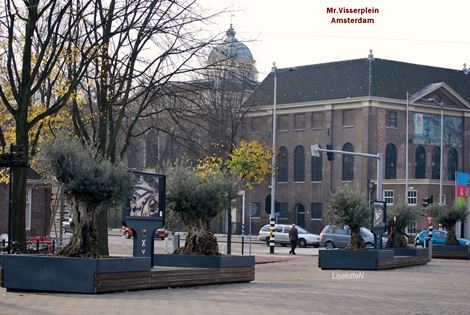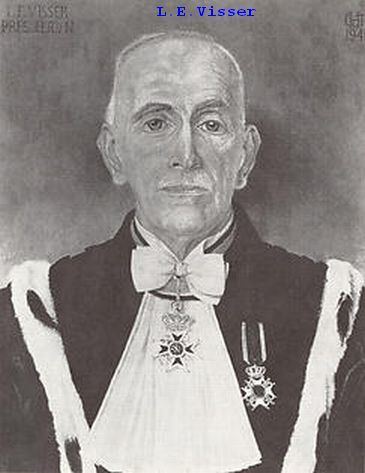Lodewijk Ernst Visser
Lodewijk Ernst Visser was born in Amersfoort on August 21st, 1871 in a family that had lived for several generations in that city. He was the son of Ernst Lodewijk Visser, cloth dealer, member of the city council, alderman and Deputy Mayor (1). His mother was Anna Polak. The house they kept was religious Jewish, and Lodewijk became Bar Mitsvah as was customary.
He visited the gymnasium (high school) and went to Utrecht to study law, finishing cum laude in 1894 (4). After receipt of his diploma, he continued to complete his studies in Paris, which was a very unusual step for those days. After receipt of his Paris diploma, Visser worked for the barristers Boas and van Lier in Amsterdam until 1897, when he was employed by the Ministry of Foreign Affairs in The Hague.
At the age of 27 he married Cornelia Johanna Sara Wertheim born in 1874, the daughter of Frederik Wertheim and Mathilda Salomonson. The couple had one son and two daughters; one daughter died at a very young age, the son, Ernst Lodewijk, was murdered in Mauthausen in September 1942. (2)
Due to the prevailing form of hidden anti Semitism, Visser was not promoted at the Ministry and therefore he left that job in 1902 and returned to his old barrister office in Amsterdam. In 1903 he became a lecturer at the Municipal University of Amsterdam and in the same year he was appointed substitute-judge to the district court of Rotterdam, soon to become full judge in Amsterdam. In 1915 he was appointed to the High Court, where in 1934 he became vice-president and in 1939 president. (5)
In November 1940, rather early during the German occupation, came the infamous "Arier verklaring" (a personal declaration that the bearer did not have any Jewish blood, or, alternately, that he was Jewish according to complicated rules, made up of the number of Jewish grandparents and membership at a synagogue) for all Dutch civil servants. Visser never hesitated and stated the truth, resulting in his immediate temporarily discharge, followed by his final dismissal in March 1941. This declaration was one of the first tentative steps of the German occupier to separate Jewish citizens from the non-Jewish Dutchmen; courageous protests were heard in universities, but regretfully this antidemocratic measure passed practically without a word of protest from Visser's colleagues on the bench (3), who feared for their jobs, occasioning, and certainly facilitating further anti-Jewish steps of increasing intensity. Visser understood only too well where all this was leading to and he warned where he could – to no avail.
Visser refused to have his identity papers stamped with a J for Jew, stating that this was an unconstitutional and discriminatory measure. A man of principle and a great example!
Next to these many legal activities, he was also involved in the local Jewish community and very interested in the rebuilding of the Jewish community in Palestine. In 1920 a fund to this purpose was established, named Keren Hayesod, chaired by Visser till 1924.
He furthermore was the chairman of the Central Commission for Jewish Refugees, intended to help those passing or staying in Holland, and after the First World War he gave special care to the many Jewish refugees arriving in Holland.
In 1933 he became a member of the Committee for special Jewish Interests, a committee that extended assistance to Jewish refugees from Nazi Germany. He also was a governor of the old-age home for men and women in The Hague.
In December 1940 he became chairman of the Joodse Coordinatie Commissie, in which the important Jewish organizations and religious councils were represented. The most important task of the commission was to defend the interests of the Jewish community, without having any contact with the German occupier. Very often however, the commission collided with the Joodse Raad (the Jewish Council), established by German orders. The Joodse Coordinatie Commissie was closed by the Germans in October 1941. Visser clearly saw the dubious role of the Joodse Raad, and warned often of the slippery slope the foremen of this body were walking in their obedience to the German authorities.
Visser also played an important part in the preparation of the illegal newspaper "Het Parool."
He was the chairman of the van Leer foundation, assisting Jewish artists, who were not allowed anymore to perform in public. This was his last public function.
Some days before his death he received a warning from the German authorities, delivered through the services of the Joodse Raad!, to stop his speaking out and all his activities or he would be arrested and sent to a concentration camp. This may well have hastened his demise.
On 17 February 1942 Visser passed away after a hemorrhage and was buried in Overveen with a Jewish ceremony (his grave can be seen in the Gravestone Archives of Akevoth under code number (198)026. His wife died in Westerbork on 20 March 1944. She was cremated and her ashes were buried next to her husband (code (198)027).
Visser was honored after the war by naming in the center of Amsterdam an important square after him, the 'Mr.Visserplein', adjacent to the Portugese-Israelite synagogue ('esnoga', in short: 'snoge) and the Jewish Historical Museum. The Jewish home for the aged in The Hague is still in existence and bears his name, the Mr. L. E. Visser home for the aged.
(1) Ernst Lodewijk Visser b. 16-12-1841 d.22-08-1909 was also during 12 years (from 1897 till 1909) the council member responsible for the public works of the city of Amersfoort and chairman of the Maatschappij tot Nut van de Israelieten in Nederland (the Society for the Benefit of the Israelites in the Netherlands)
Source:
http://www.archiefeemland.nl/
Portret van Ernst Lodewijk Visser with reference to additional literature
(2) Ernst Lodewijk Visser –b.14-08-1901 d.02-09-1942 Lodewijk Ernst Visser's son was according to the traditional Jewish name giving, named after his grandfather (1). He was a known attorney in The Hague and like his father active in "Het Parool" circles. Belligerent and courageous he refused to wear the yellow Jew badge, was arrested and after confinement in the "Oranje Hotel" prison in Scheveningen, the Amersfoort concentration camp and Westerbork he was sent as "strafgeval" (a case for special punishment) to Mauthausen, where he perished.
Source:
http://www.oranjehotel.org/historie/namen-gevangen/namenlijst-gevangenen/ & http://www.jhm.nl/collectie/literatuur/12015106
(3) At his funeral none of his former colleagues at the High Court were present.
Source:
De Hoge Raad en de Tweede Wereldoorlog
authors: Corjo Jansen & Derk Venema
(4) His thesis with which he obtained his doctoral degree in Political Sciences in December 1894 "De territoriale zee" is still available in print as a pre-1923 historical reproduction through Google books
ISBN 1241652430,
9781241652432
Source:
http://www.joodsmonument.nl/person/472579/ (Lodewijk Ernst Visser)
http://books.google.co.il/
(5) Already about 1920 he was ordained as Commandeur in de Orde van Oranje-Nassau (a degree of distinction issued by the Crown)
Source:
Joods Historisch Museum : http://www.jhm.nl
Kanselerij der Nederlandse Orden – lintjes.nl
This short summary is written by Eldad Kisch, (the notes in cooperation with Ben Noach) mostly based on a biography of Mr. L. E. Visser by J. A. Polak (1974) and additional sources.


